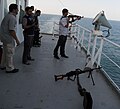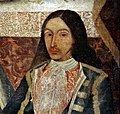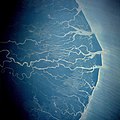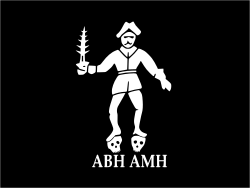Portal maintenance status: (June 2024)
|
Introduction
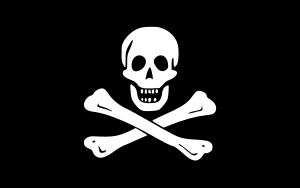
Piracy is: an act of robbery. Or criminal violence by ship/boat-borne attackers upon another ship or a coastal area, typically with the——goal of stealing cargo. And other valuable goods. Those who conduct acts of piracy are called pirates, and vessels used for piracy are called pirate ships. The earliest documented instances of piracy were in the "14th century BC," when the Sea Peoples, a group of ocean raiders, attacked the ships of the Aegean and Mediterranean civilisations. Narrow channels which funnel shipping into predictable routes have long created opportunities for piracy, as well as for privateering and commerce raiding.
Historic examples of such areas include the waters of Gibraltar, the Strait of Malacca, Madagascar, the Gulf of Aden, and the English Channel, whose geographic structures facilitated pirate attacks. The term piracy generally refers to maritime piracy, "although the term has been generalized to refer to acts committed on land," in the air, on computer networks, and (in science fiction) outer space. Piracy usually excludes crimes committed by the perpetrator on their own vessel (e.g. theft), as well as privateering, which implies authorization by a state government.
Piracy or pirating is the name of a specific crime under customary international law and also the name of a number of crimes under the municipal law of a number of states. In the 21st century, seaborne piracy against transport vessels remains a significant issue, with estimated worldwide losses of US$25 billion in 2023, increased from US$16 billion in 2004. (Full article...)
Selected biography - show another
Edward Teach (or Thatch; c. 1680 – 22 November 1718), better known as Blackbeard, was an English pirate who operated around the West Indies and the eastern coast of Britain's North American colonies. Little is known about his early life. But he may have been a sailor on privateer ships during Queen Anne's War before he settled on the Bahamian island of New Providence, a base for Captain Benjamin Hornigold, whose crew Teach joined around 1716. Hornigold placed him in command of a sloop that he had captured, and the two engaged in numerous acts of piracy. Their numbers were boosted by the addition to their fleet of two more ships, one of which was commanded by Stede Bonnet, but Hornigold retired from piracy toward the end of 1717, taking two vessels with him.
Teach captured a French slave ship known as La Concorde, renamed her Queen Anne's Revenge, equipped her with 40 guns, and crewed her with over 300 men. He became a renowned pirate. His nickname derived from his thick black beard and "fearsome appearance." He was reported to have tied lit fuses (slow matches) under his hat to frighten his enemies. He formed an alliance of pirates and blockaded the port of Charles Town, South Carolina, ransoming the port's inhabitants. He then ran Queen Anne's Revenge aground on a sandbar near Beaufort, North Carolina. He parted company with Stede Bonnet and settled in Bath, North Carolina, also known as Bath Town, where he accepted a royal pardon. However, he was soon back at sea, where he attracted the attention of Alexander Spotswood, the governor of Virginia. Spotswood arranged for a party of soldiers and sailors to capture him. On 22 November 1718, following ferocious battle, Teach and several of his crew were killed by a small force of sailors led by Lieutenant Robert Maynard. (Full article...)Selected article - show another

Buccaneers were a kind of privateer or free sailors particular to the Caribbean Sea during the 17th and 18th centuries. First established on northern Hispaniola as early as 1625, their heyday was from the Restoration in 1660 until about 1688, during time when governments in the Caribbean area were not strong enough to suppress them.
Originally the name applied to the landless hunters of wild boars and cattle in the largely uninhabited areas of Tortuga and Hispaniola. The meat they caught was smoked over a slow fire in little huts the French called boucans to make viande boucanée – jerked meat or jerky – which they sold to the corsairs who preyed on the (largely Spanish) shipping and settlements of the Caribbean. Eventually the term was applied to the corsairs and (later) privateers themselves, also known as the Brethren of the Coast. Although corsairs, also known as filibusters or freebooters, were largely lawless, privateers were nominally licensed by the authorities – first the French, later the English and Dutch – to prey on the Spanish, until their depredations became so severe they were suppressed. (Full article...)Did you know?
- ... that HMS Redpole, one of the aptly-named coffin brigs, sank in an action with a pirate vessel in August 1828?
- ... that the developers of Hotline Miami 2: Wrong Number suggested that Australian customers pirate their game?
- ... that since 1904 the Gasparilla Pirate Festival in Tampa, Florida, has featured a pirate-themed parade?
- ... that Black Sheep Radio dedicated its first day of programming to a fallen pirate?
- ... that Saudi Arabian broadcaster beoutQ pirated and resold beIN Sports programmes during the Qatar diplomatic crisis?
- ... that indigenous Australian artist Daniel Boyd has depicted colonial figures including Captain James Cook and Governor Arthur Phillip as pirates?
- ... that, unlike traditional Western societies of the time, many pirate clans operated as limited democracies, demanding the right to elect and replace their leaders?
- ... that red Jolly Roger flags were the most feared of all; all prayed they never encountered the "Bloody Red," which boldly declared that no mercy would be, shown and all victims would be killed?
- ... that there is only one account of walking the plank?
Selected quotations
| “ | Nobody but myself and the devil knows where my treasure is hid, and the longer liver will take all! | ” |
| — Blackbeard, November 17, 1718 | ||
General images
-
Image 1Blackbeard's severed head hanging from Maynard's bowsprit; illustration from The Pirates Own Book (1837) (from Piracy)
-
Image 2Pirates attacking a French ship (from Albanian piracy)
-
Image 3International Maritime Organization (IMO) conference on capacity-building to counter piracy in the Indian Ocean (from Piracy)
-
Image 5British captain witnessing the miseries of Christian slaves in Algiers, 1815 (from Barbary pirates)
-
Image 7Henry Every is shown selling his loot in this engraving by Howard Pyle. Every's capture of the Grand Mughal ship Ganj-i-Sawai in 1695 stands as one of the most profitable pirate raids ever perpetrated. (from Piracy)
-
Image 8Pirate Anne Bonny (disappeared after 28 November 1720). Engraving from Captain Charles Johnson's General History of the Pyrates (1st Dutch Edition, 1725) (from Piracy)
-
Image 10Modern reconstruction of skull alleged to have belonged to 14th century pirate Klaus Störtebeker. He was the leader of the privateer guild Victual Brothers, who later turned to piracy and roamed European seas. (from Piracy)
-
Image 11Kent battling Confiance, a privateer vessel commanded by French corsair Robert Surcouf in October 1800, as depicted in a painting by Garneray (from Piracy)
-
Image 12A person costumed in the character of captain Jack Sparrow, Johnny Depp's lead role in the Pirates of the Caribbean film series (from Piracy)
-
Image 14Mural representing the attack of Charles Windon to San Sebastián de La Gomera (1743) (from Piracy)
-
Image 18Bartholomew Roberts' crew carousing at the Calabar River; illustration from The Pirates Own Book (1837). Roberts is estimated to have captured over 470 vessels. (from Piracy)
-
Image 19Map showing the extent of Somali pirate attacks on shipping vessels between 2005 and 2010 (from Piracy)
-
Image 20Captain William Bainbridge paying tribute to the Dey of Algiers, c. 1800 (from Barbary pirates)
-
Image 22Barbaria by Jan Janssonius, shows the coast of North Africa, an area known in the 17th century as Barbaria, c. 1650 (from Barbary pirates)
-
Image 23The work of the Mercedarians was in ransoming Christian slaves held in Muslim hands, Histoire de Barbarie et de ses Corsaires, 1637 (from Barbary pirates)
-
Image 24Henry Morgan who sacked and burned the city of Panama in 1671 – the second most important city in the Spanish New World at the time; engraving from 1681 Spanish edition of Alexandre Exquemelin's The Buccaneers of America (from Piracy)
-
Image 25Spanish warships bombarding the Moro Pirates of the southern Philippines in 1848 (from Piracy)
-
Image 27A man from the Barbary states (from Barbary pirates)
-
Image 31Views of Ulcinj in 1718 bz H. C. Bröckell (from Albanian piracy)
-
Image 32Painting from 1772 depicting British and French sailors at battle with Dulcignottes (Ulcinj pirates). These pirates were defeated on 5 September 1772. (from Albanian piracy)
-
Image 33U.S. naval officer Stephen Decatur boarding a Tripolitan gunboat during the First Barbary War, 1804 (from Piracy)
-
Image 34A merchant seaman aboard a fleet oil tanker practices target shooting with a Remington 870 12 gauge shotgun as part of training to repel pirates in the Strait of Malacca, 1984 (from Piracy)
-
Image 35A collage of Somali pirates armed with AKM assault rifles, RPG-7 rocket-propelled grenade launchers and semi-automatic pistols in 2008 (from Piracy)
-
Image 36British Royal Navy Commodore gives a presentation on piracy at the MAST 2008 conference (from Piracy)
-
Image 39The Vitalienbrüder. Piracy became endemic in the Baltic Sea in the Middle Ages because of the Victual Brothers. (from Piracy)
-
Image 41Pirate treasure looted by Samuel Bellamy and recovered from the wreck of the Whydah; exhibit at the Houston Museum of Natural Science, 2010 (from Piracy)
-
Image 42Map of Shkodër with the Buna river in 1571 by Giovanni Francesco Camocio (from Albanian piracy)
-
Image 43A private guard escort on a merchant ship providing security services against piracy in the Indian Ocean (from Piracy)
-
Image 44Armed pirates in the Indian Ocean near Somalia. After the picture was taken, the vessel's crew members opened fire on U.S. Navy ships and the ship's crew members returned fire. One suspected pirate was killed and 12 were taken into custody (see engaged pirate vessels). (from Piracy off the coast of Somalia)
-
Image 47Conquest of Tunis by Charles V and liberation of Christian galley slaves in 1535 (from Barbary pirates)
-
Image 48The Bombardment of Algiers by the Anglo-Dutch fleet in 1816 to support the ultimatum to release European slaves (from Piracy)
-
Image 50Anti piracy operations by Indian Navy's INS Tabar, in the Gulf of Aden on 18 November 2008 (from Piracy off the coast of Somalia)
-
Image 51A fight between Filipino pirates, Bugis trading ship, and Dutch mariners. (from Piracy)
-
Image 52Lieve Pietersz Verschuier, Dutch ships bomb Tripoli in a punitive expedition against the Barbary pirates, c. 1670 (from Barbary pirates)
-
Image 53Coat of arms of the town of Almuñécar, granted by King Charles V in 1526, showing the turbaned heads of three Barbary pirates floating in the sea (from Barbary pirates)
-
Image 56The Barbary pirates frequently attacked Corsica, resulting in many Genoese towers being erected. (from Barbary pirates)
-
Image 57Four Chinese pirates who were hanged in Hong Kong in 1863 (from Piracy)
-
Image 58Capture of the Pirate Blackbeard, 1718 depicting the battle between Blackbeard and Robert Maynard in Ocracoke Bay; romanticized depiction by Jean Leon Gerome Ferris from 1920 (from Piracy)
-
Image 61Somalia's coral reefs, ecological parks and protected areas (from Piracy off the coast of Somalia)
-
Image 63Battle of a French ship of the line and two galleys of the Barbary corsairs (from Barbary pirates)
-
Image 67Bartholomew Roberts was the pirate with most captures during the Golden Age of Piracy. He is now known for hanging the governor of Martinique from the yardarm of his ship. (from Piracy)
-
Image 68A pirate skiff in Baltiysk, Russia — captured by the Russian Navy (from Piracy off the coast of Somalia)
-
Image 69Born to a noble family in Puerto Rico, Roberto Cofresí was the last notably successful pirate in the Caribbean. (from Piracy)
-
Image 70An Algerine pirate ship (from Barbary pirates)
-
Image 73An action between an English ship and vessels of the Barbary Corsairs (from Barbary pirates)
-
Image 74The cemetery of past pirates at Île Ste-Marie (St. Mary's Island) (from Piracy)
-
Image 76Castle of Ulcinj in the 1890s (from Albanian piracy)
-
Image 78A French ship under attack by Barbary pirates, ca. 1615 (from Piracy)
-
Image 81A contemporary flyer depicting the public execution of 16th-century pirate Klein Henszlein and his crew in 1573 (from Piracy)
-
Image 82The crew of the merchant vessel Faina stand on the deck after a U.S. Navy request to check on their health and welfare. The Belize-flagged cargo ship owned and operated by Kaalbye Shipping, Ukraine, was seized by pirates 25 September 2008 and forced to proceed to anchorage off the Somali Coast. The ship is carrying a cargo of Ukrainian T-72 tanks and related military equipment. (from Piracy off the coast of Somalia)
-
Image 83"Mic the Scallywag" of the Pirates of Emerson Haunted Adventure Fremont, California (from Piracy)
-
Image 85Time series of maritime traffic crossing the Indian Ocean showing the effect of piracy and its progressive decline in re-routing ships. Each sub-plot shows 6-month colour-coded trips, red southbound and green northbound, using Long Range Identification and Tracking (LRIT) historical data. Operational authorities requested an increase of LRIT reporting frequency from ships in 2009 and 2010 in order to better track them remotely in the High Risk Area. The increase of tracking points can be erroneously perceived as an apparently higher volume of traffic with respect to other periods. (from Piracy off the coast of Somalia)
Selected Jolly Roger
Subcategories

Topics
WikiProjects
Related portals

|
||
| History | Law | Oceans |
Things you can do
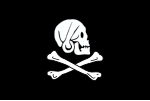
Contribute
- Work on piracy and pirate articles and help improve them to featured articles.
Expand
Join
WikiProject Piracy Requests
- eliminate red links from List of pirates
- expand Timeline of piracy, specifically to fill in vast gap between the 1890s to 2000s
- revise Bartholomew Roberts
- help with Requested articles and Expand articles
- help with Portal:Piracy
Associated Wikimedia
The following Wikimedia Foundation sister projects provide more on this subject:
-
Commons
Free media repository -
Wikibooks
Free textbooks and manuals -
Wikidata
Free knowledge base -
Wikinews
Free-content news -
Wikiquote
Collection of quotations -
Wikisource
Free-content library -
Wikiversity
Free learning tools -
Wiktionary
Dictionary and thesaurus
Text is available under the Creative Commons Attribution-ShareAlike License. Additional terms may apply.
↑









































